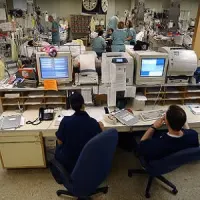Atrial fibrillation (AF) is the most common arrhythmia encountered in the intensive care unit. Pre-existing AF is highly prevalent among older patients with chronic conditions who are at risk for critical illness, while new-onset AF can be triggered by accelerated atrial remodelling and arrhythmogenic triggers encountered during critical illness. However, the lack of a strong evidence base results in substantial practice variation in the choice of strategies for management of new-onset AF during critical illness, according to a review paper to appear in the journal CHEST.
"The acute loss of atrial systole and onset of rapid ventricular rates that characterise new-onset AF often lead to decreased cardiac output and haemodynamic compromise. Thus, new-onset AF is both a marker of disease severity as well as a likely contributor to poor outcomes – similar to other manifestations organ dysfunction during critical illness," the paper explains.
In the ICU, the paper says, AF is more frequent among patients receiving vasopressor agents, in patients with electrolyte derangements and in patients with greater disease severity. For example, hypokalaemia and changes in the balance of autonomic activity as a result of vasopressors may alter ion-channel activity and cell automaticity that predispose to AF. Dopamine and epinephrine in particular have chronotropic effects which can lead to increased atrial ectopic discharges triggering new AF.
"Evaluating immediate haemodynamic effects of new-onset AF during critical illness is an important component of rapid clinical assessment aimed to identify patients in need of urgent direct current cardioversion, treatment of reversible inciting factors, and identification of patients who may benefit from pharmacologic rate or rhythm control," write Nicholas A. Bosch, MD, Boston University School of Medicine, Department of Medicine, The Pulmonary Center, and co-authors.
In addition to acute haemodynamic effects, the authors say new-onset AF during critical illness is associated with both short- and long-term increases in the risk of stroke, heart failure and death, with AF recurrence rates of approximately 50 percent within 1-year after hospital discharge.
The treatment priorities of AF in the ICU depend on multiple factors, including the goals of care of the patient, inciting events/reversible triggers, comorbid disease, haemodynamic effects, and the risks of potential therapeutic agents. "Within this context, we recommend a multifaceted approach to the management of acute AF in critical illness based upon current physiological understanding and observational evidence," say Dr. Bosch and co-authors.
The authors, however, note that there is significant practice variability regarding initial medication choice for AF during critical illness. In the United States, for example, calcium channel blockers (CCBs) are administered as initial treatment most frequently (36%) for patients with AF and sepsis, followed by beta-blockers, or BBs (28%), digoxin (20%) and amiodarone (16%). Practices also vary by country: a survey of intensivists in the UK found that greater than 80% would choose amiodarone as first line treatment, while only 12% chose BBs.
After critical illness, decisions to initiate anticoagulation to reduce thromboembolic risk depend on the persistence of arrhythmia, thromboembolic and bleeding risks, and goals of care, according to the paper. Among survivors of critical illness, new-onset AF frequently resolves prior to discharge, and thus "secondary AF" has long been thought of as a self-limited event in patients where the AF trigger is transient. However, emerging evidence suggests that AF after critical illness often reoccurs following resolution of critical illness and that long-term outcomes following critical illness may be associated with arrhythmia persistence or reoccurrence.
"Future studies of AF in the ICU will help guide our ability to predict, prevent, and manage this frequent and potentially devastating arrhythmia. Improvements in technology to identify the timing and duration of AF in the ICU using automated detection algorithms and mining of large ICU electronic medical records will help us to understand the temporal association between risk factors and AF and potentially inform mechanisms," the authors write. "Long-term AF detection techniques may also help to identify patients after ICU hospitalisations who are most likely to benefit from thromboembolism prophylaxis."
Source: CHEST
Image Credit: Pixabay
References:
Bosch NA, Cimini J, Walkey AJ (2018) Contemporary Reviews in Critical Care Medicine: Atrial Fibrillation in the Intensive Care Unit. CHEST (2018), doi: 10.1016/j.chest.2018.03.040
Latest Articles
ICU, atrial fibrillation, AF, critical illness
The lack of a strong evidence base results in substantial practice variation in the choice of strategies for management of new-onset AF during critical illness, according to a review paper to appear in the journal CHEST.










